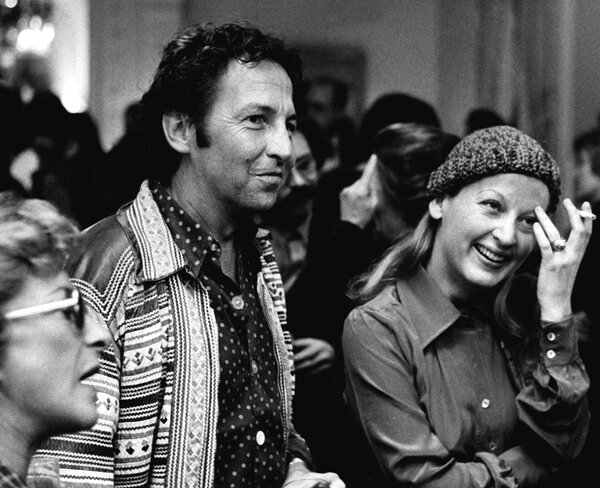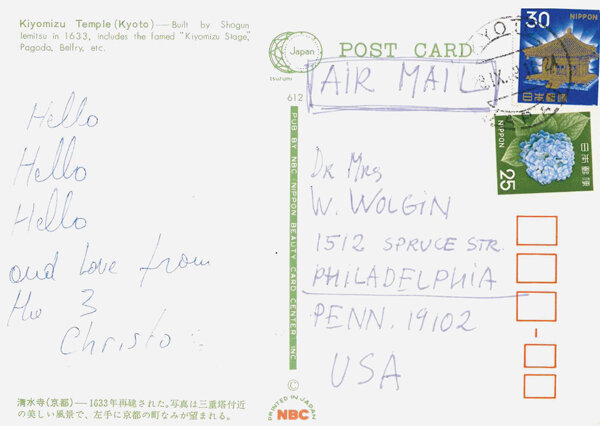222
222
This work was produced in collaboration with Harold Persico Paris.
Silver and base metal
Signed Harold Persico Paris + Arnaldo Pomodoro
Inner circ. 18 in, pendant hangs 7 in
estimate: $3,000–5,000
result: $6,930
follow artist

As consummate patrons of the arts, Acey and Bill Wolgin did not just live with the art that they collected—they lived alongside the artists who made it. Through their generous support of both individual artists as well as institutions they cherished, the Wolgins became widely celebrated collectors known for their friendships with artists—including Andy Warhol, Jasper Johns, Claes Oldenburg, Roy Lichtenstein, Arman, and Robert Rauschenberg—that were sustained, not least, by legendary parties thrown at their Philadelphia apartment.
Bill Wolgin, who practiced as a urologist, met Acey through her brother with whom he attended medical school. The pair married and made strong roots in Philadelphia—indeed, the Wolgins may be credited for having a significant role in elevating the City of Brotherly Love to the cultural destination that it is today. In the 1960s, Acey was a founding member of the Arts Council at the Young Women’s Hebrew Association, which helped spark the city’s contemporary art scene. In 1974, Acey became one of the first women elected to the board of the Philadelphia Art Museum, where she served as a trustee and trustee emeritus for the rest of her life. When Robert Indiana’s LOVE stamp was released at that museum, Acey’s birthday party doubled as the event after-party. Among the attendees was the artist Arman, who absconded with a piece of the LOVE stamp-themed cake in order to seal it in resin.

The Wolgins would later relocate to Boca Raton, where they became actively involved in the Boca Raton Museum of Art and eventually funded the Wolgin Education Center. After returning to Philadelphia, Bill Wolgin would become involved in the Woodmere Art Museum as a trustee, helping to guide the institution’s expansion. Works from the Wolgin Collection are now held in all three of the institutions where they became involved, including Yves Klein’s Portrait Relief I: Arman at the Philadelphia Museum of Art, Fletcher Benton’s Donut with Balls and Half Moon at the Boca Raton Museum of Art, and a group of large-scale sculptures by Sam Maitin at the Woodmere Art Museum.

Surrounded by his parents’ collection from a young age, Richard Wolgin recalls meeting many of the artists whose works he knew intimately—especially memorable was the flaming red hair of Jeanne-Claude when she and Christo dropped in one weekend. (When they weren’t celebrating together, the Wolgins kept correspondences with many of their artist-friends, who sent postcards and, sometimes, drawings.) As kids, Richard and his sister would, naturally, delight in playing with one of Harry Bertoia’s sound sculptures. When Richard was twelve years old, Acey gave him his first work: Roy Lichtenstein’s CRAK!, which he affixed to his bedroom wall with thumb tacks—inadvertently bringing the work back into the realm of mass media and pop cultural detritus that so inspired Lichtenstein.
The works featured in The Acey and Bill Wolgin Collection represent a life lived through, and for, art—“It’s not just buying something to hang on the wall,” says Richard, “it’s a piece of their lives, that are now part of our lives.”
Arnaldo Pomodoro b. 1926
Arnaldo was born in 1926 in Morciano, Emilia Romagna, Italy, and he first worked as a restorer on public buildings. Giò was born in 1930 in Orciano di Pesaro, Italy, and he initially trained to become a land surveyor. They both trained in goldsmithing, but Arnaldo left the craft to work as a set designer before entering the world of sculpture. This experience introduced Arnaldo to concepts of “ideology, myth and form,” leading to an emotional sense of baroque drama in his sculptures. Arnaldo honed his craft in metalwork exclusively, while Giò explored multiple mediums including fiberglass, colored marbles, clay, and wood in his sculptures. In 1956, Giò was invited to exhibit at the Venice Biennale, and in 1959 his work was on display at Kassel in Germany. Three years after Giò, Arnaldo was invited to exhibit at the Venice Biennale in 1962. Moving to the United States in 1966, Arnaldo became a professor of sculpture, teaching first at Stanford University and later at University of California, Berkeley. The work of both brothers is held in the permanent collections of museums across the world. Giò’s sculptural creations are on view at the Hirshhorn Museum in Washington D.C., the Los Angeles County Museum of Art, and the Museo d’Arte Moderna in Mexico. Arnaldo’s works are on display at the Guggenheim Museum in New York, the Milwaukee Museum of Art, and Princeton University Art Gallery, among many others.
Auction Results Arnaldo Pomodoro